Nets tend to be one of those things that many fly anglers opt to do without longer than they should. Most often, this is because it seems like something the average trout angler (and most fly anglers are trout anglers) can do without—like an optional accessory. And there's some truth to this. Certainly not all anglers need nets, and those that do need them don't necessarily need them on every outing, but rare is the angler—especially the catch and release angler—that can't benefit from having the option to tote along a net when headed to the water.
Why carry a net?
The best reason to carry a net on the water is also the most obvious one—it makes landing fish a lot easier. Big fish, little fish, fair-hooked fish, foul-hooked fish, it matters not. Landing fish is easier when you have a net. If you prefer to return the fish you catch to the waters they swim in, nets also make for a more successful release as, in most scenarios, you’ll be able to dramatically reduce the amount of contact and handling the fish experiences, as well as increase your ability to easily and comfortably revive your catch. And, speaking of pictures, if you like to photograph fish, you’ll also be able to do so much more effectively with a landing net as you’ll have the opportunity to let the fish rest and recover in the net before attempting to snap a shot.
But which net to carry?
There is no shortage of nets to buy. Amazon sells over 1,000 different nets. Many of the big box stores sell hundreds. Prices range from as cheap as 10 bucks, to hundreds. But, if you’ve been through a number of nets in your life, you probably know that you generally get what you pay for. Cheap nets don’t last long, thanks to being built from cheap materials that wear quickly and also tend to be unkind to your catch (think coarse nylon and rope net bags that are harmful to fish). Cheap nets also tend to be one-size-fits all and that size is usually way too small or way too big. And, despite being light on the wallet, cheap nets are typically heavy (literally).
And so we’ve come to see nets, like most of our fly fishing gear, as an investment; one we’re willing to spend a bit more on to ensure we’re getting the performance, durability and the quality we want. Over the last few months, we’ve been on the water with a variety of nets geared towards anglers that wade all or part of the time, and have selected a few that we think should be on your list of candidates. Each of these nets features a thick, rubber net bag that is safe for your catch, so we won’t be detailing that below.

Fishpond Nomad Hand Net
Fishpond acquired netmaker Nomad in 2013, and today Fishpond’s entire net lineup consists of Nomad nets, a line of exclusively carbon fiber and carbon composite nets. If Fishpond ever made other nets, we’ve forgotten what they were, mostly because Nomad nets are so stinking nice. The carbon fiber frame construction of all Nomad nets makes them both sturdy and incredibly light—the latter being the characteristic you’ll notice (or, rather, not notice) day in and day out thanks to not having a heavy net pulling on your shoulder or waist when on the water.
If you primarily fish for small to mid-sized (with the occasional large) trout, feel free to minimize the size of the net you need to carry and focus on hand nets. At 26” long, Fishpond’s Nomad Hand net is the second shortest net Fishpond sells, but unlike its 1/2” shorter Native net, comes with an oversized and deeper basket that will allow you to scoop up even large fish. For all that extra room, you’re adding on only 2 ounces, and at less than a pound (only .88 pounds / 400 grams), you’re talking about a net so light you’ll forget it’s there. It's also worth mentioning that all of the Nomad nets float, so should one get lose in the stream, it won't head straight for Davy Jones' locker before you have a chance to retrieve it. Whether it floats its way to the ocean before you catch it, well, that's another story.
Orvis Nomad Mid-Length Camo Net
Here’s the thing about larger nets: they offer increased reach, increased leverage and bigger net bags. The first of those advantages is simply nice, especially for aging backs. The other two are must-haves when it comes to bigger fish. But, bigger nets are also, well, bigger. And sometimes that’s undesirable when you’re on foot all day and are lugging around a bunch of other gear.
The question is, can you have your cake and eat it too? As far as we’re concerned, when it comes to the mid-length version of the Orvis Nomad Camo Net (pictured at top), the answer is yes. Of all the nets we tested, the Orvis Nomad Mid-Length Camo net (which is a Nomad model manufactured exclusively for Orvis) was far and away our favorite for trout angling, thanks to proportions that offer all of the big net advantages while not ever feeling like much more to carry than a hand net.
With baskets that have identical dimensions, you can think of the Orvis Nomad Mid-Length Camo net as the Nomad Hand net with a much longer handle—9” longer, for a total length of 37”. Yet, somehow—we’re not sure how the math works out—the mid-length net also clocks in at .88 pounds. Oh, and the brown trout camo pattern on these nets is one we really dig.

Hex Fly Co. Steelhead Reach Net
Newcomer Hex Fly Co.’s Steelhead Reach Net, at 33” long, falls somewhere in between a hand net and the Orvis mid-length net. So it might fit the bill because you’re looking for something in the middle. More likely, it will fit the bill due to its unique, tough-as-nails, wood and steel design. If getting to your favorite stretch of swing water requires bushwhacking and boulder-hopping or if you have a penchant for slamming the tailgate of your truck on your gear, you should probably look in this direction.
Hex’s Steelhead Reach net marries an oak hardwood handle with a basket made entirely from spring steel. Spring steel, if you’re not already familiar with it, is high-carbon steel that’s bendable and pliable, and returns to shape after being deformed. You’ll most commonly find it in automotive construction, but you’ll also find it in everything from piano wire to binder clips and even in some knives. In this case, it’s used in a simple but elegant design to make a fishing net—one that you can kick the crap out of.
There’s a tradeoff for this bulletproof durability—the Steelhead Reach net is noticeably heavier than the rest of the nets listed here. For most people, noticeably heavier won't be too heavy, and as Hex Fly Co. works to expand its net offerings (the Steelhead Reach net is its debut model), they are also working on incorporating lighter woods and steel types that won’t sacrifice durability.

Fishpond Nomad El Jefe Net
Yep, another Nomad net. Sorry, they’re good product.
If you spend most of your time chasing bigger fish and are looking for a net that can do double duty on your hip pack or your boat, the El Jefe is a solid choice. With a basket that’s almost 22” long with a 14” deep net bag, the El Jefe can swallow up big fish (think steelhead, salmon, musky and so on). At 42” long, it offers plenty of leverage, enough reach for the oarsman to net fish with ease, but still be a reasonable carry (just) on wade days. And still crazy light, at only 1.2 pounds.

Rising Brookie Net + Extension
Torn between choosing a small, compact hand net and something with a bit more reach and leverage? Well, maybe you don’t have to be. Rising, an innovative company out of Utah, has created a system of aluminum-framed nets that have extendable handles—like Rising’s Brookie Net. Headed out for brook trout on the creek one day? Go sans handle and tote along a hand net that’s only 26” long. Headed out for big, fall brown trout the next day and want extra reach and leverage? Pop off the end cap and screw on the 14” handle extension and you’ve got a landing net that’s almost as long as the El Jefe. The basket on the Brookie is a bit narrow near the handle, so you might want to opt for Rising’s Stubby Lunker, which has a larger basket, instead of the Brookie if you’re lucky enough for large fish to be a regular part of your angling instead of a rare occurrence. Oh, and if you don't dig the red, don't worry—Rising's nets all come in at least 8 different colors. It’s nice to have options.













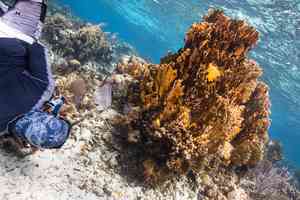

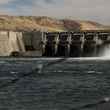






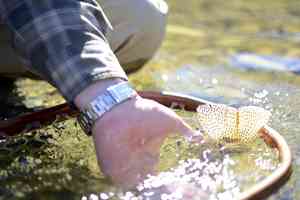
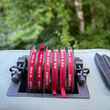




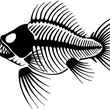

Comments
Mike Lundrigan replied on Permalink
No folding telescopic nets in your review? I carry one in a sleeve bag with a drawstring opening on a shoulder strap which stops tangles in the bushes and gives me easy access with security...
It cost me $25 and a repurposed folding camp chair bag! Good idea to have the bag in an easy to see colour!
Pages